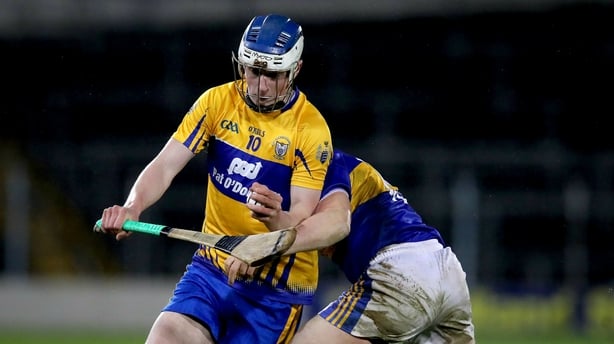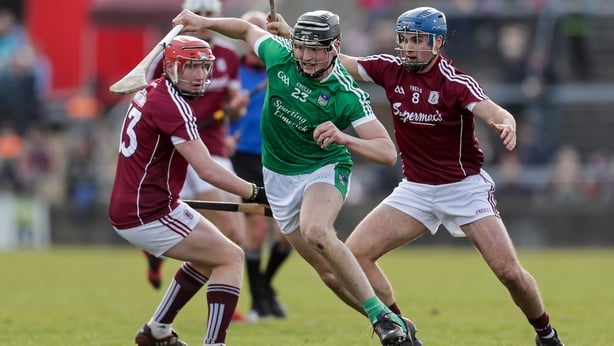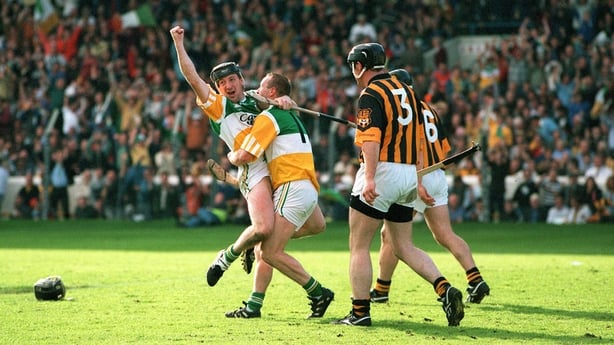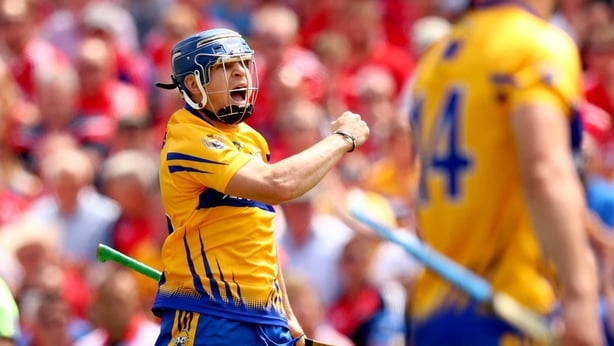In the 45th minute of Sunday’s Clare-Kilkenny game in Ennis, Conor Cleary played a crossfield pass to Diarmuid Ryan, just outside the Clare ‘45 metre line. With Conor Delaney closing in on him, Ryan turned back on his right before hopping the ball into the ground to allow Shane Golden take the pass in his stride.
At that stage, Ryan and David Fitzgerald, who were both behind Golden, began sprinting hard up the field. As soon as Fitzgerald came off Golden’s shoulder, Golden released the hand-pass to Fitzgerald.
With Ger Aylward chasing after Fitzgerald and Paul Murphy coming to meet him, Fitzgerald played a long hand-pass across to Ryan, who was storming through the centre after making a 50 metre run in seven seconds. After taking the pass on his hurley before securing possession, Ryan drove the ball over the bar.
That style demands incredible work-rate and discipline from their half-forwards, especially when they have to push up to press the opposition puck-out.
Four minutes later, Ryan was back behind his own 45-metre line again when Cathal Malone took a stick pass from David McInerney. As soon as Malone secured possession, Ryan took off sprinting again up the sideline.
Malone stepped inside Delaney before slipping the pass through to Ian Galvin, who immediately dinked it on to the onrushing Ryan. The angle was far tighter this time around but Ryan split the posts from outside the 45-metre line.

Ryan was centrally involved again in Golden’s point in the 52nd minute, hoovering up possession 50 metres from his own goal before playing a stick pass into his club-mate, Podge Collins, who immediately offloaded to the onrushing Golden.
Those three scores underlined how Clare can cut teams apart with their slick and incisive running game but Ryan’s central role in all three points also neatly encapsulated the demands of the modern hurling half-forward.
His starting position for all three scores was in the Clare half-back line. Ryan is comfortable back there because he played as a half-back with Cratloe in last year’s county final.
He is equally at ease going forward because Ryan was an outstanding attacking midfielder for Ardscoil Rís last season; in two key Dr Harty Cup games against Middleton CBS, Ryan hit a combined 1-9 from play.
Ryan bagged three points from play on Sunday but, on a squad loaded with attacking talent, his class, physique, pace and athleticism have put the 19-year old smack bang in the middle of an emerging Clare picture.

He is ideally suited to Clare’s running/offloading game but Ryan also neatly matches the template largely set by Limerick’s half-forwards last year – Gearoid Hegarty, Kyle Hayes and Tom Morrissey; big, athletic, rangy, strong, powerful, pacy players, all well able to score.
Yet how they fit into the Limerick system is central to how well that system functions; like Ryan on Sunday, at least two of the Limerick half-forwards will come deep as they work the ball out of defence before launching the attack. And once the attack is launched, mostly from cross-field deliveries, bodies are committed forward at massive pace.
That game requires massive fitness, pace and athleticism but the deep lying presence of half-forwards is so counter-attacking in nature because of the defensive cover, and structure, it provides.
As well as compressing the opposition’s attacking space, that structure also gives a constant out-ball option as teams work the ball out of defence as they begin the attack.

The game is continually changing. Positions are as fluid now as in Gaelic football but the evolution of the modern half-forward really began in the latter half of the 1990s, and particularly in the championship battles between Offaly and Kilkenny.
Both sets of half-forwards would drift out the field, with the half-back lines reluctant to follow them out. Hurling back then wasn’t defined by the short stick-passing, pop passing and running style of the modern game but those Offaly-Kilkenny half-forward/half-back tussles was largely a battle of wits; both would stand their ground, with the half-backs trying to hold the line, to see who would crack first. And whoever did, usually lost the game.
The challenge for half-back lines now though, is completely different. When a half-forward goes that deep, do you follow your man? In the modern game, most defenders probably feel they can’t, primarily because of the exposed space it will leave behind them.
Limerick certainly don’t. They always hold a tight defensive line across their own 45, especially on their own puckout. If opposition half-forwards are drifting up the pitch, they’ll invariably be engaged by Hegarty or Tom Morrissey. And as soon as Limerick begin working the ball out to the 65, those two are often the first point of contact before the pass is played inside.

That style demands incredible work-rate and discipline from their half-forwards, especially when they have to push up to press the opposition puck-out, before then working hard down the field to win try and win possession back.
Limerick’s method of play is clearly defined but that defensive structure still allows for tactical fluidity and creativity. Peter Casey’s point on Saturday evening against Tipp provided a neat example because it was engineered by Paddy O’Loughlin from the half-back line.
After winning a Tipperary puck-out, O’Loughlin charged forward before releasing the sliotar to Morrissey, who then slipped the pass to Hayes, who in turn picked out O’Loughlin who had kept sprinting forward. O’Loughlin picked up the ball in the corner-forward position before slipping it back to Casey.
O’Loughlin was playing as a half-back but he had the licence to move forward because a couple of Limerick players had wheeled back into their defence to provide the cover in case the attack broke down.
The engine room of most teams now is their half-forward line.
It is absolutely central to Limerick’s style. And as Diarmuid Ryan showcased for Clare on Sunday, when that attacking game from deep is slickly stitched together, it can be devastating.


